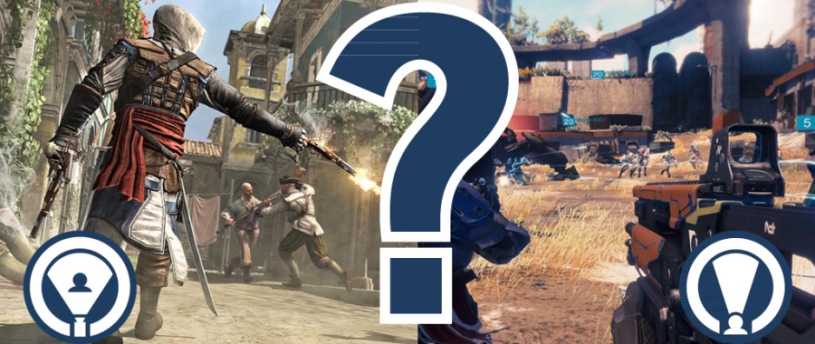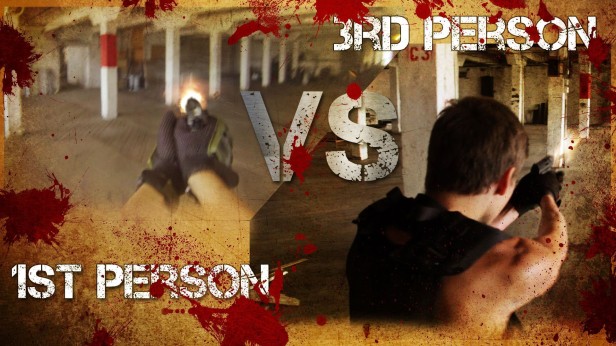Picture this: you are a game developer, and you are currently working on a shooter. Obviously you are going to design weapons that pack a punch, program the AI so that it can adapt to sundry in-game situations , and design environments that can accommodate multiple combat tactics and strategies that can range from close quarters combat to long-range sharpshooting.
All of those things are important, and can make the difference between a great shooter and a poorly-made one. But one of the very first design choices a developer has to make when building such a complex game is: first-person or third-person?
It’s a question that sounds simple enough at first glance. Do I want the player to see the action and experience the world through the eyes of the main character, or would it better for the player’s avatar to be featured onscreen? After all, we all have our personal preferences when it comes to virtual camera systems.
But from my point of view, the difference between first-person and third-person games goes much deeper than that. You see, a graphical perspective can drastically alter a game’s presentational and gameplay nature. Many factors come into play when making certain design decisions, and the question of in-game perspective is no exception. In fact, failure to take this particular gameplay element seriously will very likely result in your game controlling horribly, and having a disjointed “feel”.
I’ll elaborate on this particular issue by giving you a couple of reasons why first-person and third-person games can be vastly different from one another. For each reason, I’ll offer two explanations: one for first-person games, and one for third-person games.
NOTE: I’m going to be looking mostly at shooters and games that control similarly to them, and the titles I’m going to present do not necessarily represent their entire respective genre.
Also, I know there are games that utilize both perspectives with varying levels of success. But in this article, I’ll be mainly looking at the differences between the two camera systems and not how they can both work in the same game (although that’s something I might cover in a future article).
1) Immersion (presentation)
The first important factor that separates first-person games from third-person ones is the sense of immersion the player feels when he is playing a game. Immersion is what enables the player to ignore his real-world surroundings and be engrossed into the experience. Although first-person and third-person games can be immersive, the way they achieve immersion is quite different from one another. One of two outcomes may occur when playing from a particular perspective.
1a) Environmental/player bond
The first outcome occurs when the first-person perspective is being used. In this instance, the player essentially assumes the identity of the avatar and sees the world through his eyes. By “becoming” the avatar, the player also embodies his character’s traits and demeanor, and the intensity of in-game situations is ramped up considerably because of that.
Take, for instance, the horror game Alien: Isolation. The game is played from a first-person perspective, meaning that the player views the world from the eyes of the protagonist, Amanda Ripley. The player IS Ripley: he is put right in the middle of the in-game situation. In a horror game, this means that aspects like atmospheric tension and jump scares can be made even more potent by playing the game from a first-person perspective.
To give you an idea of what I’m trying to say, let’s take a look at a video showcasing the game in first-person:
Granted, watching footage of Alien: Isolation on YouTube doesn’t really do the game justice. But one thing is for sure: playing the game in first-person feels terrifying because the player has to bear the anxiety Amanda feels as a result of being put in her shoes. This frightening feeling stems not only from the incredible audiovisual presentation, but also from the game’s effective use of the first-person perspective.
Compare that with third-person footage of the same game (apologies for the horrendous quality. It’s all I could find):
Is it scary? Maybe, but the third-person footage certainly lacks the level of fear and dread seen in the first-person video. Why? Because the Alien is not hunting the player: it is hunting Amanda Ripley. As a result, the player no longer felt like he was the one in danger, and that would have removed a lot of the game’s tension had the developers kept the third-person perspective in the final game.
1b) Player/character bond
Speaking of third-person, games that feature the player avatar onscreen immerse the player in a different way, and that’s when the second outcome occurs: whereas first-person games attempt to immerse the player by forging a bond between his avatar and the game world, third-person games accomplish that same feat by instead forging a bond between the player and the onscreen avatar. So the immersion factor in third-person games doesn’t come from how the player feels about the environment he is interacting with: it comes from how the player feels about the character he is controlling, and how the game world treats that character.
A good example of a third-person game in which the player witnesses the changes being made to his avatar is Spec Ops: The Line. The player assumes control of Captain Martin Walker, but he doesn’t become his avatar: he witnesses his avatar’s actions, and the way he interacts with the game world and vice versa. Anyone who has played the game knows just how grim and twisted the game can be, and Spec Ops’ dark tone immerses the player into the post-apocalyptic rendition of Dubai by exposing him to the suffering and pain Walker has to endure.
As a result, the player is immersed into the experience by identifying with the character’s struggle, not necessarily by bearing the struggle himself (WARNING: spoilers ahead):
Even so, the player is still fully engrossed into the experience because of what he is witnessing. The omnipresent poignancy is made all the more palpable by the game’s use of the third-person perspective. The player might not feel the dread that burdens Walker, but he can certainly see it. Games that show and don’t tell usually do a great job of immersing the player into their worlds, and Spec Ops: The Line is one such game: a gloomy journey that presents the player with tough situations that his onscreen avatar has to face.
2) Reflexes (gameplay)
The second factor that’s affected by the game’s virtual camera system is the way the player uses his reflexes when controlling his character. How quickly a game moves and the point of view from which the player is seeing the game can have a great effect on the playing experience. This is where pacing and controls come into play, and they must be taken into strong consideration by the game designer.
Because of the difference in perspective between first-person and third-person shooters, the game developer has to fine-tune the game’s movement and shooting models in order to obtain the type of gameplay he wants the player to experience. In fact, shooting and movement are key components of the degree of control the player has while playing a game, and each perspective has its own advantages and disadvantages on both fronts.
2a) Fast and Furious
First-person shooters tend to be twitchy and fast-paced affairs, and for good reasons: the fact that you can easily see what’s in front of you enables you to react more quickly to what’s going onscreen. This increased frontal awareness also lead to more accurate shooting, with or without the help of crosshairs, compared to what you would get in a third-person shooter. The same can be said about movement since you don’t need to worry about having a playable avatar block the screen. even if that means having less overall spatial awareness.
This is why we have first-person shooters like Quake and Rise of the Triad, games that encourage you to think swiftly and dynamically on-the-fly as you put your enemies out of their misery with your trusty rifle or shotgun and navigate the environment at an extremely fast rate. Granted, that level of speed can potentially be disorienting and even cause motion sickness to some players, but it’s that same element that gives first-person shooters their instinctive and visceral edge, something that would be less effective had those games utilized a third-person perspective.
2b) Slow and Steady
A third-person shooter, in comparison, comes with its own bag of tricks (and quirks). Since you have a wider field of view and see the action from the back of your onscreen avatar, you have a much better sense of spatial awareness and orientation, making navigation breezier and spotting enemies/obstacles in the game world less tedious. Because the camera system is doing the spatial grunt work for you, controlling your character is simpler in a third-person shooter than in a first-person shooter.
However, the shooting model in third-person shooters isn’t as accurate as that found in first-person shooters since you are experiencing the action from afar. In older third-person shooters like Max Payne and SOCOM, the game would have the camera system centered on the onscreen avatar. Modern third-person shooters employ an over-the-shoulder perspective to minimize the issue of screen obstruction seen in older games, but the decreased accuracy still means you have to take it slow when trading gunfire with your enemies. Games like Uncharted and Warhammer 40,000: Space Marine embody most of the gameplay traits shared by third-person shooters.
So even though both Quake and Space Marine make blasting enemies with meaty weapons a top priority, the pacing and control differences give each game its own gameplay identity and rhythm. Those are elements that the game designer has to strongly consider when polishing and optimizing the mechanics for his game. The position of the camera alone can have a huge impact on the way the game operates, and alter the player’s reflexes.
By now you should have a better understanding of what goes under the presentational and gameplay hood of first-person and third-person games. A game’s perspective can radically change the way that game operates and feels. Again, it’s not just about whether or not you want to be staring at your character for the entirety of the game. The game designer has to work hard to accommodate the perspective he is going to use, or else the game would suffer greatly from sloppy execution.
Let me know what you think of the reasons I’ve listed above, and feel free to share your opinion with me or ask me questions! I’ll do my best to reply to your comments and messages.



It’s truly a great and helpful piece of info.
I am glad that you just shared this useful information with us.
Please keep us informed like this. Thank you for sharing.
LikeLike
I know that this post is almost 3 years-old, but I wanted to tell you that I found your explanations enlightening and incredibly well-done! Thank you for posting this out here.
LikeLiked by 2 people
Honestly, this is one of the best articles I’ve read on this matter. One thing I would point out, although you did touch upon it, is that linear story-heavy games tend to lean towards third-person. Take the latest Sony exclusives: from the new God of War to pretty much any Naughty Dog game https://rawg.io/developers/naughty-dog. It’s just the standard these days if you want to deliver a cinematic story, go for third-person. Looks like the industry has a lot to learn until it will be capable of telling stories by means of the gameplay.
LikeLiked by 1 person